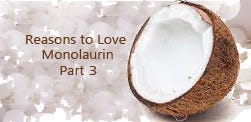What’s so special about monolaurin? Well, how much time ya got?
What I thought would be a short article about one of nature’s impressive little marvels, turned into a multi-part series—The more I researched this amazing substance, the more profound my admiration for it became.
So welcome to Part 3 of this longform piece about what might just be the most under-promising, over-delivering, easy-to-fall-in-love-with supplement out there.
And although I had meant for this to be the final installment for this series, Substack just sent me that note again—”Post too long for email”—so I’ve broken this into a Part 3 and a Part 4 to stay within the email limit.
Part 3 focuses on monolaurin’s antiparasitic activity & Part 4 will be all about monolaurin’s antifungal and immunomodulatory actions. But please start reading at Part 1 for important context if you’re new to this series.
I’ve often said that if I wasn’t a doctor, I’d do something professionally with monolaurin, EMDR, or Costco (Who doesn’t like Costco?—Just check out their return policy—90 days, even for electronics!!)—Such is my passion for all three. No, I’m not employed by Costco—If only…
But my love for monolaurin runs deep—As reviewed in Part 1, its amazingly selective antibacterial action results in the destruction of disease-causing bacteria while sparing the beneficial ones of our microbiome. And as reviewed in Part 2, it’s remarkably broad-spectrum antiviral activity against a huge array of enveloped viruses, examples of which include Covid, influenza, RSV, all herpes viruses, HIV, and countless others, is almost the stuff of legend. And here in Part 3, I’ll review its antiparasitic actions.
Monolaurin has got to be one of the hardest working supplements on the planet.
Keep reading with a 7-day free trial
Subscribe to ZeroSpin to keep reading this post and get 7 days of free access to the full post archives.



